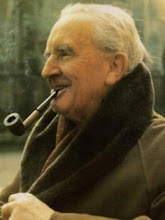 It may come as a surprise to some readers that The Lord of the Rings is the culmination of a much greater history. Even to many ''fans'' (I hate that word) the legends that comprise The Silmarillion, Unfinished Tales and The History of Middle-earth, are completely unknown, or if they are, they are perceived as garbled accounts of an obscure, un-Hobbit-like period, badly written, and they are perhaps left unread.
It may come as a surprise to some readers that The Lord of the Rings is the culmination of a much greater history. Even to many ''fans'' (I hate that word) the legends that comprise The Silmarillion, Unfinished Tales and The History of Middle-earth, are completely unknown, or if they are, they are perceived as garbled accounts of an obscure, un-Hobbit-like period, badly written, and they are perhaps left unread.When J.R.R Tolkien was about my age, during the First World War, he began to write a collection of stories that were later collected and published posthumously (in 1983 and 1984 respectively) as The Book of Lost Tales Part I, and Part II. In these stories, or legends, first appear Elves* and Men, conceived as the Children of Ilúvatar (the Creator), the Valar (Powers, angelic beings equivalent, in some respects at least, to some pagan gods, and forming a kind of ''pantheon''); the satanic Dark Lord Melko, called the ''foe of Gods and Men'' by Úrin the Man, Balrogs, Orcs, Valinor (the blessed land in the West and home of the Valar), and the ''Great Lands'' which later became known as Middle-earth. Hobbits were thought of years later, and were not then conceived as part of these stories (let alone as a significant part).
However, to produce a kind of ''synopsis'' of these legends is, I think, impossible. As Tolkien himself wrote in an undated letter to Milton Waldman (it was probably written late in 1951): ''It is difficult to say anything without saying too much: the attempt to say a few words opens a floodgate of excitement, the egoist and artist at once desires to say how the stuff has grown, what it is like, and what (he thinks) he means or is trying to represent by it all.'' (The Letters of J.R.R Tolkien, no: 131).
Instead of inflicting all this on you in one post, over the next few days I shall write several posts about the different stages of composition. By the way, I have called the title of this post ''a sacred legendarium'' - I can't remember why now, perhaps I had a fleeting moment of inspiration or some fantastic notion that has long gone.
* I shall write many posts on the ''Elves;'' a name that Tolkien didn't much like. The word is too often understood as referring to tiny, twinkly fairies with magic wands; and not an ancient and noble people, only equivalent to what can only be described as ''unfallen'' Men, a people like Men, but with enhanced aesthetic abilities, wiser, longeval.

No comments:
Post a Comment